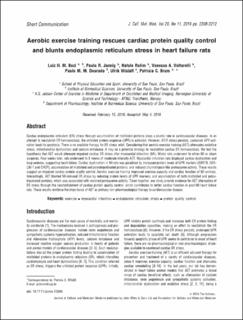| dc.contributor.author | Bozi, Luiz H.M. | |
| dc.contributor.author | Jannig, Paulo R | |
| dc.contributor.author | Rolim, Natale Pinheiro Lage | |
| dc.contributor.author | Voltarelli, Vanessa | |
| dc.contributor.author | Dourado, Paulo MM | |
| dc.contributor.author | Wisløff, Ulrik | |
| dc.contributor.author | Brum, Patricia C. | |
| dc.date.accessioned | 2020-04-30T13:15:36Z | |
| dc.date.available | 2020-04-30T13:15:36Z | |
| dc.date.created | 2016-12-15T11:17:32Z | |
| dc.date.issued | 2016 | |
| dc.identifier.citation | Journal of Cellular and Molecular Medicine. 2016, 20 (11), 2208-2212. | en_US |
| dc.identifier.issn | 1582-1838 | |
| dc.identifier.uri | https://hdl.handle.net/11250/2653084 | |
| dc.description.abstract | Cardiac endoplasmic reticulum (ER) stress through accumulation of misfolded proteins plays a pivotal role in cardiovascular diseases. In an attempt to reestablish ER homoeostasis, the unfolded protein response (UPR) is activated. However, if ER stress persists, sustained UPR activation leads to apoptosis. There is no available therapy for ER stress relief. Considering that aerobic exercise training (AET) attenuates oxidative stress, mitochondrial dysfunction and calcium imbalance, it may be a potential strategy to reestablish cardiac ER homoeostasis. We test the hypothesis that AET would attenuate impaired cardiac ER stress after myocardial infarction (MI). Wistar rats underwent to either MI or sham surgeries. Four weeks later, rats underwent to 8 weeks of moderate‐intensity AET. Myocardial infarction rats displayed cardiac dysfunction and lung oedema, suggesting heart failure. Cardiac dysfunction in MI rats was paralleled by increased protein levels of UPR markers (GRP78, DERLIN‐1 and CHOP), accumulation of misfolded and polyubiquitinated proteins, and reduced chymotrypsin‐like proteasome activity. These results suggest an impaired cardiac protein quality control. Aerobic exercise training improved exercise capacity and cardiac function of MI animals. Interestingly, AET blunted MI‐induced ER stress by reducing protein levels of UPR markers, and accumulation of both misfolded and polyubiquinated proteins, which was associated with restored proteasome activity. Taken together, our study provide evidence for AET attenuation of ER stress through the reestablishment of cardiac protein quality control, which contributes to better cardiac function in post‐MI heart failure rats. These results reinforce the importance of AET as primary non‐pharmacological therapy to cardiovascular disease. | en_US |
| dc.language.iso | eng | en_US |
| dc.publisher | John Wiley & Sons | en_US |
| dc.rights | Navngivelse 4.0 Internasjonal | * |
| dc.rights.uri | http://creativecommons.org/licenses/by/4.0/deed.no | * |
| dc.title | Aerobic exercise training rescues cardiac protein quality control and blunts endoplasmic reticulum stress in heart failure rats | en_US |
| dc.type | Peer reviewed | en_US |
| dc.type | Journal article | en_US |
| dc.description.version | publishedVersion | en_US |
| dc.source.pagenumber | 2208-2212 | en_US |
| dc.source.volume | 20 | en_US |
| dc.source.journal | Journal of Cellular and Molecular Medicine | en_US |
| dc.source.issue | 11 | en_US |
| dc.identifier.doi | 10.1111/jcmm.12894 | |
| dc.identifier.cristin | 1413225 | |
| dc.description.localcode | © 2016 The Authors. This is an open access article under the terms of the Creative Commons Attribution License, which permits use, distribution and reproduction in any medium, provided the original work is properly cited. | en_US |
| cristin.ispublished | true | |
| cristin.fulltext | original | |
| cristin.qualitycode | 1 | |

